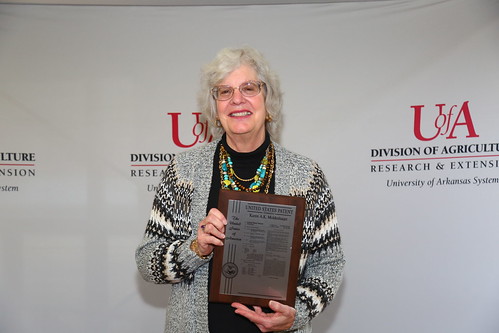Division of Agriculture study examines global benefits of public plant breeding programs
By Ryan McGeeney
U of A System Division of Agriculture
Jan. 18, 2019
Fast Facts:
- New study examines more than three decades of breeding and economic data
- Study sees positive effects on low-income food costs from public plant breeding programs
- Rice varieties from the U of A System Division of Ag make up about 60 percent of Arkansas rice acreage
(685 words)
(Download this story in MS Word format here.)
FAYETTEVILLE, Ark. – In the decades since land grant universities first began developing hardier strains of rice, corn and other agricultural commodities, the benefit to growers has been clear: Increased yield, disease resistance and greater profitability, made widely available through taxpayer-funded research.
A new study, co-authored by four University of Arkansas System Division of Agriculture experts, looks at how such programs benefit consumers around the world, as well.
“Estimating the Benefits of Public Plant Breeding Programs,” slated to be published in an upcoming volume of the Journal of Agricultural Economics, was co-authored, in part, by Lanier Nalley, professor of agriculture economics for the department of agricultural economics and agribusiness, and Karen Moldenhauer, professor of crop, soil, and environmental science. Alvaro Durand-Morat, a research assistant professor for the Division of Agriculture, and Aaron Shew, now an assistant professor and the Wilson Chair of Agricultural Business at Arkansas State University, were also co-authors.
The study looks specifically at increases in revenue, total exports and the global welfare effects derived from the Division of Agriculture’s rice breeding program, based on data from 1983-2016.
Nalley said he and his co-authors wanted to examine the broader effects of public plant breeding programs, in terms of social and economic impacts.
“I think we oftentimes think of plant breeding and increased yields and just ‘making more money for producers,’ which is a great thing, but the positive externality on that is that we feed a lot more people,” Nalley said. “Rice is a field-to-plate crop, so these gains we’re making in genetics are directly feeding people. Unlike soybeans or corn, which might go to feed livestock, then tangentially feed people, this rice directly feeds people.”
The study found that while the genetic gains provided by the program increased both the yield and quality of rice crops, providing growers with an additional $31 million in revenue annually, it also increased rice exports by about 53,000 metric tons and lowered food costs in low-income countries.
In the United States, breeding programs don’t dominate all agricultural commodities, but in wheat and rice, where the use of genetically modified organisms isn’t commercially allowed, publicly developed varieties account for roughly 60 percent of the rice acreage in Arkansas, Nalley said.
“Globally, it becomes a little more heterogeneous,” Nalley said, noting that rice varieties must be developed to suit specific regions. “But, for most low-income countries, public breeding is the main way increasingly successful varieties are brought to market. The research and development process itself is quite expensive, which is why it tends to become a government-funded venture.”
Moldenhauer said it takes about a decade to bring a new rice variety from its initial cross of desirable genetic traits to a finalized product ready for market.
From a rice production standpoint, the United States is a relatively “small player,” Nalley said. In 2018, the United States produced about 6.9 million metric tons of rice, compared to about 143 million metric tons produced in China and 111 metric tons produced in India, for example. However, many countries consume more than they produce, opening the market for surplus producers such as the United States, which is among the top global exporters of rice.
Nalley said that efforts to increase rice yields have helped to feed increasing numbers of people in low-income countries, where much of the population spends a majority of its disposable income on food. Through higher global grain stocks and competition, overall food prices have decreased in many of these areas.
“I think what’s lost in most breeding stories is the fact that we’re really helping people feed themselves,” he said. “We’ve seen that rice prices are reduced by 1 percent in countries such as Haiti, Nicaragua and Panama — those are very poor countries, and reducing the price of rice by 1 percent doesn’t sound like a lot, but when the majority of disposable income goes toward food, any reduction in food price makes a difference.”
About the Division of Agriculture
The University of Arkansas System Division of Agriculture’s mission is to strengthen agriculture, communities, and families by connecting trusted research to the adoption of best practices. Through the Agricultural Experiment Station and the Cooperative Extension Service, the Division of Agriculture conducts research and extension work within the nation’s historic land grant education system.
The Division of Agriculture is one of 20 entities within the University of Arkansas System. It has offices in all 75 counties in Arkansas and faculty on five system campuses.
Pursuant to 7 CFR § 15.3, the University of Arkansas System Division of Agriculture offers all its Extension and Research programs and services (including employment) without regard to race, color, sex, national origin, religion, age, disability, marital or veteran status, genetic information, sexual preference, pregnancy or any other legally protected status, and is an equal opportunity institution.
# # #
Media Contact: Ryan McGeeney
Communication Services
U of A System Division of Agriculture
Cooperative Extension Service
(501) 671-2120
rmcgeeney@uada.edu

